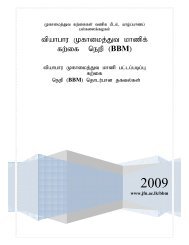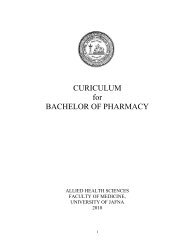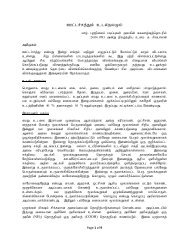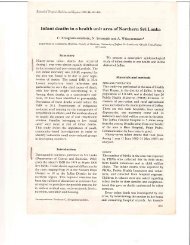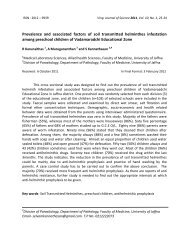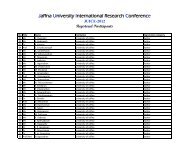MANUAL PHYSIOLOGY PRACTICAL - Repository:The Medical ...
MANUAL PHYSIOLOGY PRACTICAL - Repository:The Medical ...
MANUAL PHYSIOLOGY PRACTICAL - Repository:The Medical ...
You also want an ePaper? Increase the reach of your titles
YUMPU automatically turns print PDFs into web optimized ePapers that Google loves.
FM/UOJ<br />
Test for colour blindness:<br />
<strong>The</strong> cone pigments are essential for the perception of light by the cones. <strong>The</strong> gene<br />
for the blue sensitive cone pigment is on chromosome 7 and the genes for green and red<br />
sensitive pigments are on X chromosome. Because the red-green color blindness is sexlinked<br />
recessive characteristics, females are generally carriers and males are the sufferers.<br />
Detection of colour blindness is not easy because those who are deficient in color<br />
vision has been also perceiving the rays and they were trained to call whatever the<br />
sensation they got as the color. Various tests have been developed to identify colour<br />
blindness.<br />
Yarn-matching test:<br />
This is a simple test. <strong>The</strong> subject is presented with a skein of yarn and asked to<br />
pick out the one which matches the colour from a pile of various coloured skeins.<br />
Ishihara charts:<br />
<strong>The</strong>se are series of charts produced by tricky color dots. <strong>The</strong> subject is asked to<br />
read the number or trace the pattern in each chart and the interpretation of the response is<br />
given in a booklet.<br />
Experiment 2.7<br />
Eye Reflexes<br />
<strong>The</strong> activities of the eye are effected by skeletal and smooth muscles which are<br />
supplied by somatic and autonomic nerves. Also several portions of the eye are rich in<br />
sensory nerves and several reflexes can be demonstrated.<br />
Protective reflex:<br />
Ask the subject to look at a distance object. Bring an object (may be your hand)<br />
rapidly towards the subjects eye. Observe the blinking of both eyes.<br />
Corneal reflex:<br />
Ask the subject to look ahead. Take a wisp of cotton wool and touch the cornea<br />
gently by a side without bringing the wool in to sight. Observe blinking of both eyes.<br />
Repeat the test by touching the conjunctiva and eyelashes.<br />
Exercise: trace the pathway and describe the findings in possible lesions:<br />
………………………………………………………………………………………………<br />
………………………………………………………………………………………………<br />
………………………………………………………………………………………………<br />
………………………………………………………………………………………………<br />
………………………………………………………………………………………………<br />
………………………………………………………………………………………………<br />
………………………………………………………………………………………………<br />
Neurology<br />
Page | 149




